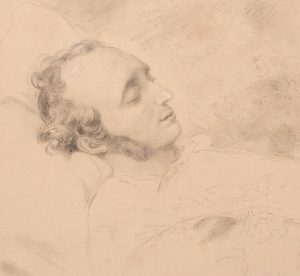
Mendelssohn on his deathbed, drawing by Wilhelm Hensel
Bodleian Library MS. M. Deneke Mendelssohn b. 1 (CC-BY-NC 4.0)
Our Henle blog this year has largely dealt with two themes: we’ve focused, first of all, on the string-quartet genre under the motto “Henle4Strings”; then alongside this, we’ve commemorated several anniversaries of great composers or of great works (composers such as Scriabin, Brahms, Franck, Kuhnau, and Bach’s Well-Tempered Clavier). As the end of the year approaches, these two strands come together in the best contrapuntal manner: today’s blog post is dedicated to the 175th anniversary of the death of Felix Mendelssohn Bartholdy, who died on 4 November 1847 but was able shortly beforehand to finalise his last significant work – the F-minor string quartet op. post. 80.
Strictly speaking, we are memorialising two Mendelssohns in 2022, for also passing away in 1847, on 14 May, half a year before her brother Felix, was his sister Fanny Hensel (née Mendelssohn). To be found, incidentally, in the Henle catalogue is also a volume of enchanting piano works published from her estate for the first time, to which we would expressly like to allude here (HN 392).
What a heavy blow Fanny’s completely unexpected death was for Felix, who idolised his older sister, can hardly be estimated. According to contemporary reports, he sank with a cry to the ground when he got the news. Already in poor health owing to exhausting concert tours and chronic overwork, he was subsequently only a shadow of his former self. The English music writer Henry Chorley, visiting him in August 1847, describes him as a stooped, greatly aged man, haunted by premonitions of death.
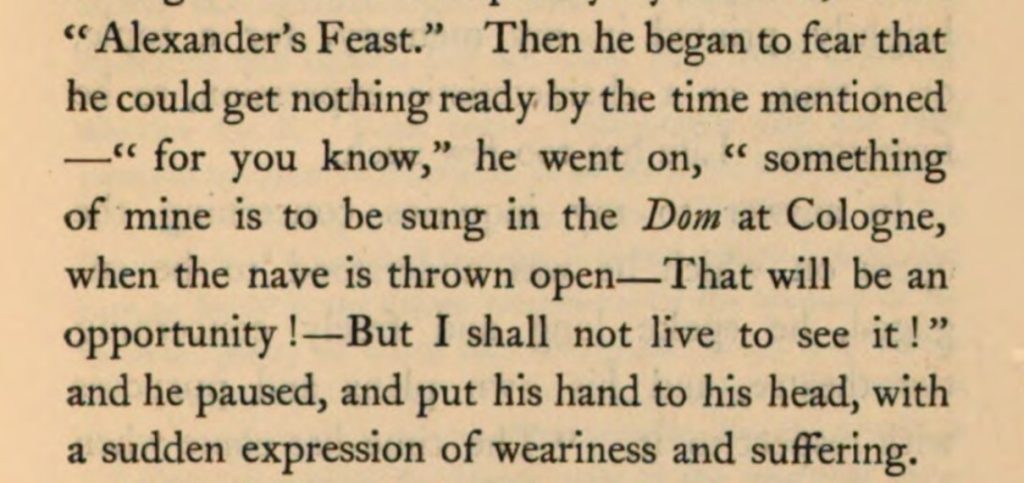
Henry F. Chorley: Modern German Music, London, 1854, p. 387; chapter titled “The Last Days of Mendelssohn”.
Mendelssohn sought recuperation in Switzerland where he travelled with his family and his brother Paul, first spending the period from the end of June to mid-September in Thun, then in Interlaken. That his productivity soon resumed can be established, contrary to some biographical accounts stating that his creative energy came to a standstill after Fanny’s death. The first indications of work on his last string quartet, the F minor, can be found as early as 6 July, when he made some musical notes in his diary for an ‘Allegro for quartet’, the beginning of the later scherzo. From the end of July onwards, his correspondence again contains increasing allusions to the fact that he was “writing notes”. Henry Chorley reports on his conversations with the composer: “He had composed much music, he said, since he had been at Interlachen; and mentioned that stupendous quartet in F minor […] besides some English service-music for the Protestant church.” To be added here is his intensive work on his opera project Die Lorelei, remaining a fragment, though he notated several complete numbers and extensive sketches and drafts. 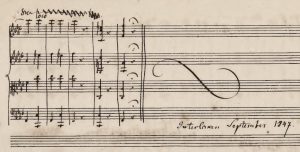 Dated on the last page of the autograph of the F-minor string quartet is “Interlaken September 1847”, so it is probably not an unreasonable speculation to see in this highly dramatic work full of painful outbursts and mood swings a kind of musical coping with grief.
Dated on the last page of the autograph of the F-minor string quartet is “Interlaken September 1847”, so it is probably not an unreasonable speculation to see in this highly dramatic work full of painful outbursts and mood swings a kind of musical coping with grief.
After his return to his native Leipzig in mid-September 1847, Mendelssohn frequently met with his close friend, the pianist and composer Ignaz Moscheles, to whose diary entries we owe further personal insights into the composer’s last days. On 5 October 1847, Moscheles recorded: ‘The whole afternoon at Mendelssohn’s with the friendliest reception and pleasant conversations about local artistic circumstances. He played me his last quartet; all four pieces in F minor. [Note: The Adagio is in the parallel key of A-flat major]. The passionate character of the whole and the sombre key seemed to me an expression of his deeply shaken soul; he was still struggling with the pain of losing his sister.’ (Aus Moscheles’ Leben, vol. 2, Leipzig, 1873, p. 177.)
During a walk together a few days later, Mendelssohn answered the question about his own health: ‘How am I doing? I am grey in grey.’ This last quartet that he had played to Moscheles only on the piano, he was not to hear in its real form – after suffering several strokes, he died on the evening of 4 November. A whole year passed before the posthumous premiere of the F-minor quartet: it was first performed in his memory on the first anniversary of his death, 4 November 1848, and appeared in print another two years later. The autograph is consequently the only relevant source for our Urtext edition (HN 678). The manuscript is now located in the Cracow Biblioteka Jagiellońska and can be studied in excellent quality on the library’s website:
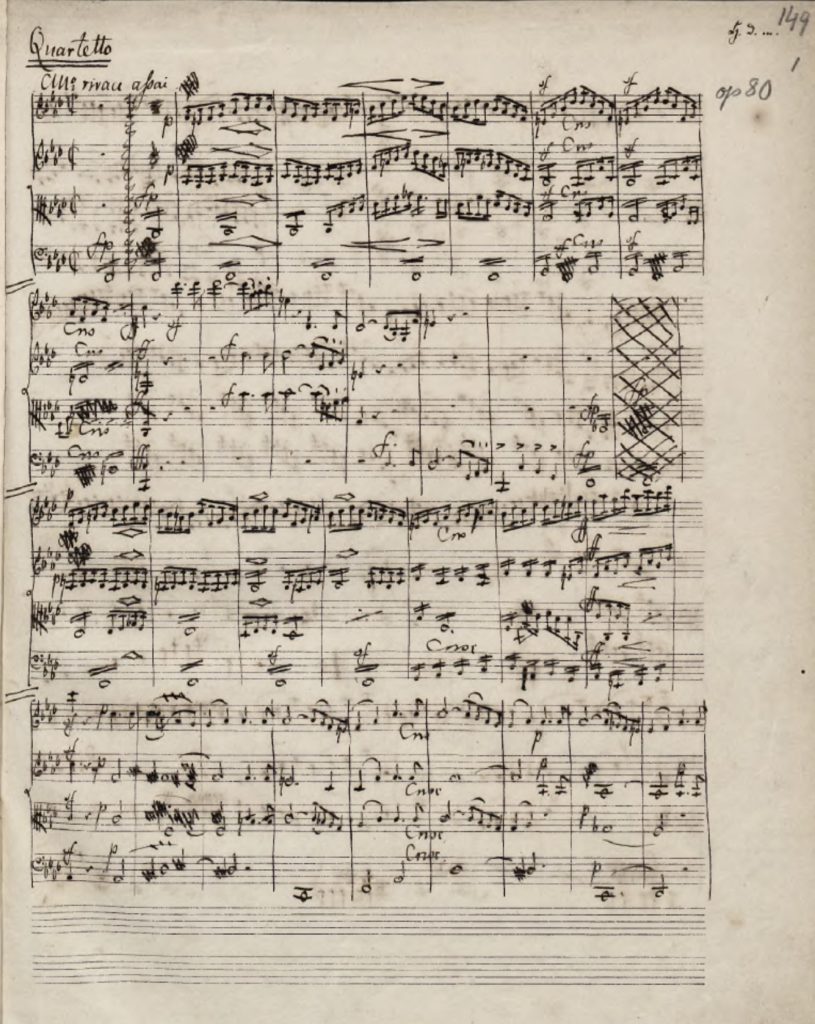
Cracow, Biblioteka Jagiellońska, Mus. ms. autogr. Mendelssohn 44/9
Fortunately, we have a complete transcription of the string quartet. But is the quartet even “finished”? The source situation at first glance seems ideal: An autograph score written down in full by the composer and easily legible despite numerous corrections – what could be more authentic?
But the matter becomes somewhat more problematic when one knows Mendelssohn’s usual working procedure (resembling in this many other composers). The first inscription usually represented merely the first step in a longer process involving many revisions and changes before the final printed publication.
His opus 44, three string quartets written about 10 years earlier, provides a vivid example of how long the compositional process could drag on. The autograph of the E-minor quartet op. 44 no. 2, the first of the collection, is dated 18 June 1837 on the last score page concluding the composition. But only a month later we learn from Mendelssohn’s letter to his friend Ferdinand Hiller, whom he had met shortly before: ‘I have made the changes in the violin quartet in E minor largely as per your advice, and it has gained a great deal […].’ (Letter of 23 July 1837) The intensive reworkings, deletions, additions and pasteovers in the autograph, which can be exhaustively studied in the Berlin State Library’s digital copy, are certainly associated with this reworking mentioned, but can also be partly traced back to the subsequent rehearsal phase in preparation for the premiere by Ferdinand David and his quartet colleagues.
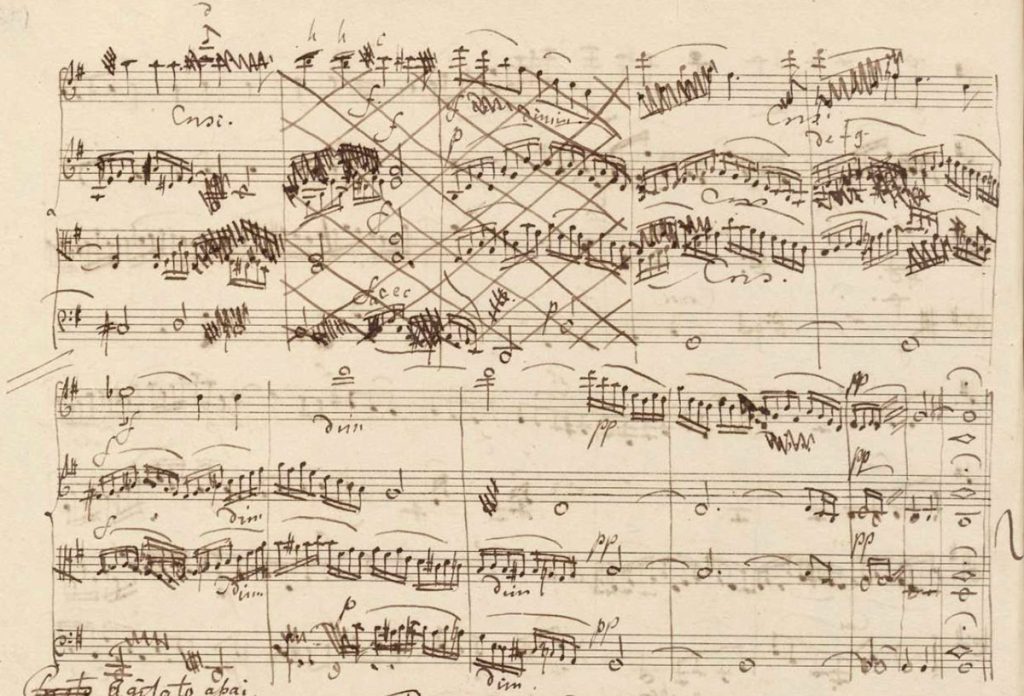
String quartet in E minor op. 44 no. 2, Andante, closing measures with deletions and corrections
Staatsbibliothek Berlin, Mus.ms.autogr. Mendelssohn Bartholdy, F. 29
The situation is not much different with the two sister works in E-flat major and D major that Mendelssohn composed in subsequent months and the year following. Manuscript parts for all three opus 44 quartets, prepared for the performances, subsequently served as engraver’s models for the first edition published by Breitkopf & Härtel. This, of course, was not done without Mendelssohn’s first having made changes to the content…. When the parts were sent to the publishing house, he accordingly apologised:
‘[You] are hereby receiving the manuscript of my Three Violin Quartets; I apologise that it has taken so long – but I have scratched and painted on the parts so that I have almost lost patience; now, I hope, they will be correct.’ (Letter of 16 November 1838)
But even in the subsequent proofreading phase, the composer still made further changes, as can be seen from these two contrite covering letters:
‘Herewith, the proofs of the D major quartet. Unfortunately, I have again indulged in my bad habit and changed 3-4 passages, but I am hopeless, and all I can do is apologise.’ (Letter of 31 January 1839)
‘[You] are herewith receiving the last proofs of my 3 quartets. […] I most sincerely apologise for readjusting so often and for so long; it is a nasty habit that I would like to break and cannot.’ (Letter of 25 February 1839)
Characteristic of his way of working would be, for example, the following passage from the scherzo of the E-flat major quartet op. 44 no. 3, where the composer apparently struggled to reconcile the parallel voice leading of the two violins in thirds with the viola’s motoric motion. In the autograph the viola omits an eighth on the 5th beat in m. 6 to avoid a dissonance with the second violin’s e, foreign to the key:
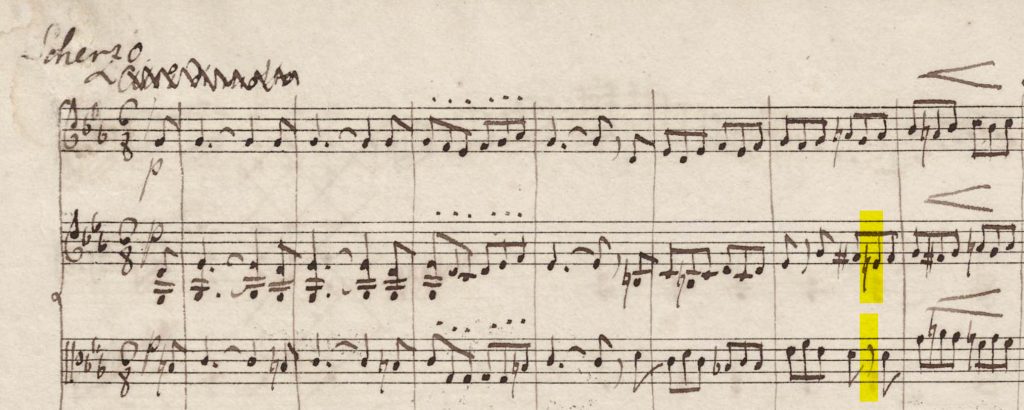
During the David Quartet’s rehearsals for the premiere, a variant was apparently tried out that was also adopted in the first parts edition: Here the viola retains the continuous eighth-note configuration, which seems more coherent from a practical point of view, though creating a harsh friction with the e of the 2nd violin on beat 5:
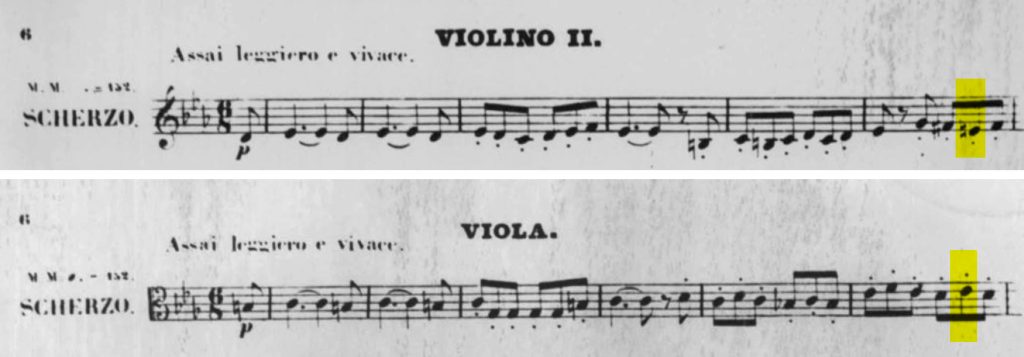
The later, first edition of the full score contains a new solution to the problem: now the 2nd violin moves to the g, thus avoiding the dissonance with the viola, but at the expense of the parallel voice leading in lower thirds to the 1st violin, analogous to m. 5:
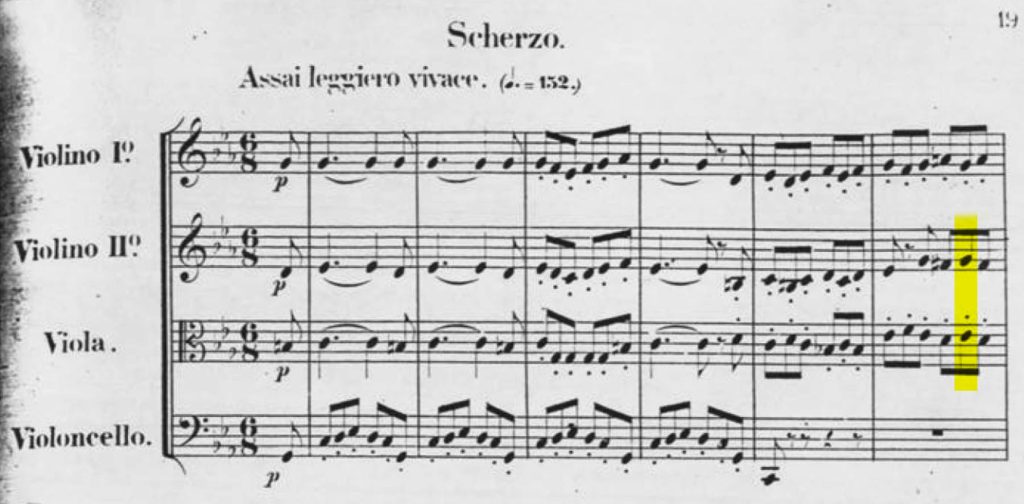
In that respect, the score seems to offer the best text, but it too is full of inconsistencies and “improvements” for the worse, probably going back to interventions by a publishing-house editor at the time, so that our Urtext edition (HN 443) nevertheless chose the first parts edition as its main source (but follows the score reading in the above example).
But back to the last quartet in F minor that received its opus number 80 only upon its posthumous publication in 1850: how would it have looked if Mendelssohn himself had prepared it for publication…? This surely would have occurred only after extensive rehearsals and post-premiere, and in many spots he would surely have added finishing touches. But even had Mendelssohn lived longer, even many years longer, whether he would ever have been able to decide on a final printed version of the quartet is still not at all certain. The best example of such a “complete/incomplete” masterpiece is his famous Symphony in A major, composed as early as 1833. The so-called “Italian”, one of the most popular works in the Romantic symphonic repertoire, Mendelssohn never, throughout his life, considered ready for publication, and with his far-reaching revisions, it remained an unfinished torso. Not many concertgoers probably know that the Italian Symphony is still performed today only in its first, 1833 version, that Mendelssohn rejected. But then again, who would consider this symphony, ravishing from beginning to end, “unfinished” or in need of revision? The same is certainly true of the F-minor quartet, which has captivated listeners for 175 years. Why not listen to it again this Memorial Day – in this live recording, for example, by our friends, the Aris Quartet?
